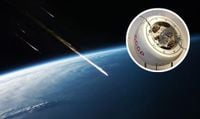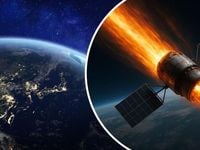The Soviet space probe Kosmos 482 is hurtling toward Earth, with predictions indicating a potential crash on May 10, 2025. After over 50 years in orbit, the probe, originally intended for a Venus landing, is now a piece of space debris that could impact populated areas across multiple continents.
As of May 9, 2025, the European Space Agency (ESA) has updated its calculations, forecasting the re-entry of Kosmos 482 at approximately 6:37 AM (UTC) on May 10, with an uncertainty of plus or minus 3.28 hours. This means the probe could crash anywhere between 3 AM and 10 AM (UTC). The latest estimates place the probe's trajectory over the Gulf of Bengal, east of Chennai, India, but it remains unclear where it will ultimately land.
Initially launched on March 31, 1972, Kosmos 482 was designed to explore Venus. However, due to a malfunction with its carrier rocket, the probe was stranded in Earth's orbit, where it has remained for more than five decades. The probe weighs about 500 kilograms and is expected to re-enter the atmosphere at a speed of around 240 km/h.
Marco Langbroek, a Dutch satellite expert, predicts a crash time of around 5:34 AM CET (Central European Time) on May 10, with an uncertainty of plus or minus 15 hours. Other institutions, including the Technical University of Braunschweig, have estimated the impact could occur shortly before 2 AM, with a deviation of plus or minus 16 hours. The ESA has also indicated that the probe could hit Earth at around 3:12 AM CET, with a deviation of plus or minus 14 hours.
The uncertainty surrounding the re-entry time and location is significant. The ESA explains that the capsule's trajectory includes a wide swath of the Earth, covering areas between the 52nd northern and 52nd southern latitudes. This range includes parts of Europe, the entire African continent, and large portions of Asia, North America, and Australia. Notably, Germany lies partially within this danger zone, as it spans from approximately the 47th to the 55th northern latitude.
As the time of re-entry approaches, the ESA emphasizes the challenges in predicting the exact crash site. The probe will make several orbits around the Earth during the re-entry window, which complicates the calculations. The current estimates suggest the capsule could be just 10 kilometers above the surface south of Australia at one point, but this does not guarantee where it will ultimately land.
In a statement, the ESA noted, "The exact location where Kosmos 482 will crash is still very uncertain." The probe's speed and the extensive area it covers during its descent make precise predictions difficult. The ESA has identified a point in the South Pacific as the 'COIW' (center of impact window), located west of Peru over the ocean. If the probe were to crash there, it would likely pose minimal risk to human life.
Despite the theoretical risks, experts stress that the statistical probability of a crash in a populated area is low. The capsule was designed to withstand the extreme conditions of Venus's atmosphere and may remain about 80 percent intact upon re-entry, according to scientists from the Technical University of Braunschweig. These researchers suggest that if the heat shield of the capsule is still functional, it could survive the descent intact, leading to a complete object landing on Earth.
However, the presence of space debris poses various environmental risks. Larger fragments can cause significant damage in ecologically sensitive areas, and there is potential for chemical contamination from toxic materials contained within some spacecraft. Although most components burn up upon re-entry, larger objects can still threaten buildings or people.
As the world awaits the fate of Kosmos 482, the situation highlights the growing issue of space debris. The ESA reports that there are currently over a million pieces of debris larger than one centimeter orbiting the Earth, with up to 3,000 new objects being launched into orbit each year, compared to just 100 two decades ago. This increasing volume of debris raises concerns about future collisions in orbit, which could generate even more space junk.
In summary, the impending crash of Kosmos 482 serves as a reminder of the complexities and risks associated with space exploration and the management of space debris. As scientists continue to monitor the situation and refine their predictions, the global community remains on alert for the potential impact of this aging Soviet space probe.






